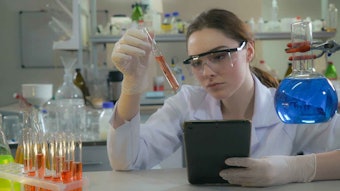
Toxicity testing in the personal care industry is crucial to ensuring consumer and environmental safety, along with commercial success. But with the advent of bans on animal testing, ingredient and product developers are left with little more than outdated test data, so-so test methods and a new challenge. That's where the light went on—literally—for researchers at North Carolina (NC) State University, who developed a novel, high-speed approach to toxicity testing.
According to the university, today's high-throughput techniques rely on reporter genes; if a chemical introduced to a cell activates the reporter gene, this response can be observed in 24 hr or more. The new approach, however, works much faster since it is based on the first step in triggering a cellular response: protein binding.
During chemical reactions, trigger proteins ("Met" proteins, in this case) recruit additional proteins ("SRC" proteins). The authors focused on the Met-SRC complex since it regulates a gene that controls reproductive development in crustaceans. Thus, its activation suggests a significant likelihood of environmental toxicity.
NC State researchers then modified both proteins such that upon recruitment, they emit light at a wavelength of 535 nm, which is a signal that can be easily measured. Their work was published in the journal Environmental Science & Technology.
Gerald LeBlanc, head of the Department of Biological Sciences at North Carolina State University and co-author on the work, explained these implications. “If we introduce a chemical to the system, we can tell almost instantaneously whether the chemical has stimulated the recruitment of SRC to Met. ... And by measuring the intensity of the light, we can also assess the potency of the chemical to activate this pathway."
This is approach could be applied to a wide variety of target proteins for most any species, significantly expediting the screening of chemicals for prioritization testing. The technique could also be used to assess chemicals for human toxicity testing.










